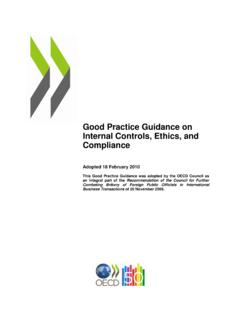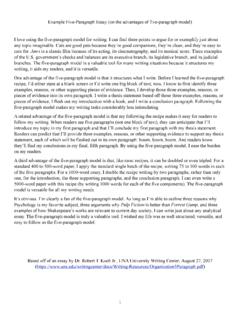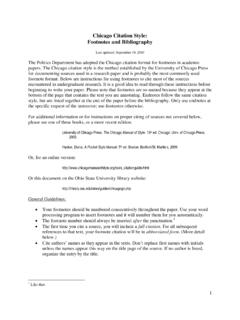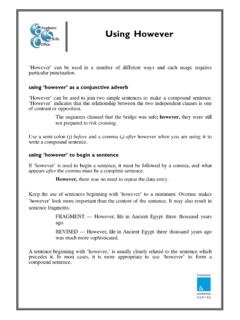Transcription of Adversarial Examples Are Not Bugs, They Are Features
1 Adversarial Examples Are Not Bugs, They Are Features Andrew Ilyas Shibani Santurkar Dimitris Tsipras . MIT MIT MIT. [ ] 12 Aug 2019. Logan Engstrom Brandon Tran Aleksander Madry . MIT MIT MIT. Abstract Adversarial Examples have attracted significant attention in machine learning, but the reasons for their existence and pervasiveness remain unclear. We demonstrate that Adversarial Examples can be directly at- tributed to the presence of non-robust Features : Features (derived from patterns in the data distribution) that are highly predictive, yet brittle and (thus) incomprehensible to humans. After capturing these Features within a theoretical framework, we establish their widespread existence in standard datasets. Finally, we present a simple setting where we can rigorously tie the phenomena we observe in practice to a misalign- ment between the (human-specified) notion of robustness and the inherent geometry of the data.
2 1 Introduction The pervasive brittleness of deep neural networks [Sze+14; Eng+19b; HD19; Ath+18] has attracted signif- icant attention in recent years. Particularly worrisome is the phenomenon of Adversarial Examples [Big+13;. Sze+14], imperceptibly perturbed natural inputs that induce erroneous predictions in state-of-the-art clas- sifiers. Previous work has proposed a variety of explanations for this phenomenon, ranging from theoreti- cal models [Sch+18; BPR18] to arguments based on concentration of measure in high-dimensions [Gil+18;. MDM18; Sha+19a]. These theories, however, are often unable to fully capture behaviors we observe in practice (we discuss this further in Section 5). More broadly, previous work in the field tends to view Adversarial Examples as aberrations arising either from the high dimensional nature of the input space or statistical fluctuations in the training data [Sze+14.]
3 GSS15; Gil+18]. From this point of view, it is natural to treat Adversarial robustness as a goal that can be disentangled and pursued independently from maximizing accuracy [Mad+18; SHS19; Sug+19], ei- ther through improved standard regularization methods [TG16] or pre/post-processing of network in- puts/outputs [Ues+18; CW17a; He+17]. In this work, we propose a new perspective on the phenomenon of Adversarial Examples . In contrast to the previous models, we cast Adversarial vulnerability as a fundamental consequence of the dominant supervised learning paradigm. Specifically, we claim that: Adversarial vulnerability is a direct result of our models' sensitivity to well-generalizing Features in the data. Recall that we usually train classifiers to solely maximize (distributional) accuracy. Consequently, classifiers tend to use any available signal to do so, even those that look incomprehensible to humans.
4 After all, the presence of a tail or ears is no more natural to a classifier than any other equally predictive feature. In fact, we find that standard ML datasets do admit highly predictive yet imperceptible Features . We posit that Equal contribution 1. our models learn to rely on these non-robust Features , leading to Adversarial perturbations that exploit this Our hypothesis also suggests an explanation for Adversarial transferability: the phenomenon that adver- sarial perturbations computed for one model often transfer to other, independently trained models. Since any two models are likely to learn similar non-robust Features , perturbations that manipulate such fea- tures will apply to both. Finally, this perspective establishes Adversarial vulnerability as a human-centric phenomenon, since, from the standard supervised learning point of view, non-robust Features can be as important as robust ones.
5 It also suggests that approaches aiming to enhance the interpretability of a given model by enforcing priors for its explanation [MV15; OMS17; Smi+17] actually hide Features that are meaningful and predictive to standard models. As such, producing human-meaningful explanations that remain faithful to underlying models cannot be pursued independently from the training of the models themselves. To corroborate our theory, we show that it is possible to disentangle robust from non-robust Features in standard image classification datasets. Specifically, given any training dataset, we are able to construct: 1. A robustified version for robust classification (Figure 1a)2 . We demonstrate that it is possible to effectively remove non-robust Features from a dataset. Concretely, we create a training set (seman- tically similar to the original) on which standard training yields good robust accuracy on the original, unmodified test set.
6 This finding establishes that Adversarial vulnerability is not necessarily tied to the standard training framework, but is also a property of the dataset. 2. A non-robust version for standard classification (Figure 1b)2 . We are also able to construct a training dataset for which the inputs are nearly identical to the originals, but all appear incorrectly labeled. In fact, the inputs in the new training set are associated to their labels only through small Adversarial perturbations (and hence utilize only non-robust Features ). Despite the lack of any predictive human-visible information, training on this dataset yields good accuracy on the original, unmodified test set. This demonstrates that Adversarial perturbations can arise from flipping Features in the data that are useful for classification of correct inputs (hence not being purely aberrations). Finally, we present a concrete classification task where the connection between Adversarial Examples and non-robust Features can be studied rigorously.
7 This task consists of separating Gaussian distributions, and is loosely based on the model presented in Tsipras et al. [Tsi+19], while expanding upon it in a few ways. First, Adversarial vulnerability in our setting can be precisely quantified as a difference between the intrinsic data geometry and that of the adversary's perturbation set. Second, robust training yields a classifier which utilizes a geometry corresponding to a combination of these two. Lastly, the gradients of standard models can be significantly more misaligned with the inter-class direction, capturing a phenomenon that has been observed in practice in more complex scenarios [Tsi+19]. 2 The Robust Features Model We begin by developing a framework, loosely based on the setting proposed by Tsipras et al. [Tsi+19], that enables us to rigorously refer to robust and non-robust Features . In particular, we present a set of definitions which allow us to formally describe our setup, theoretical results, and empirical evidence.
8 Setup. We consider binary classification3 , where input-label pairs ( x, y) X { 1} are sampled from a (data) distribution D ; the goal is to learn a classifier C : X { 1} which predicts a label y corresponding to a given input x. 1 It is worth emphasizing that while our findings demonstrate that Adversarial vulnerability does arise from non-robust Features , they do not preclude the possibility of Adversarial vulnerability also arising from other phenomena [TG16; Sch+18]. For example , Nakkiran [Nak19a] constructs Adversarial Examples that do not exploit non-robust Features (and hence do not allow one to learn a generalizing model from them). Still, the mere existence of useful non-robust Features suffices to establish that without explicitly discouraging models from utilizing these Features , Adversarial vulnerability will remain an issue. 2 The corresponding datasets for CIFAR-10 are publicly available at 3 Our framework can be straightforwardly adapted though to the multi-class setting.
9 2. Robust dataset Training image Adversarial example Relabel as cat towards cat . good standard accuracy max P(cat). Train good robust accuracy dog cat frog Robust Features : dog Robust Features : dog Unmodi ed Non-Robust Features : dog Non-Robust Features : cat test set frog Training image good standard accuracy Train good accuracy Train bad robust accuracy cat frog Evaluate on Non-robust dataset original test set (a) (b). Figure 1: A conceptual diagram of the experiments of Section 3. In (a) we disentangle Features into combi- nations of robust/non-robust Features (Section ). In (b) we construct a dataset which appears mislabeled to humans (via Adversarial Examples ) but results in good accuracy on the original test set (Section ). We define a feature to be a function mapping from the input space X to the real numbers, with the set of all Features thus being F = { f : X R}. For convenience, we assume that the Features in F are shifted/scaled to be mean-zero and unit-variance ( , so that E( x,y) D [ f ( x )] = 0 and E( x,y) D [ f ( x )2 ] = 1), in order to make the following definitions scale-invariant4.
10 Note that this formal definition also captures what we abstractly think of as Features ( , we can construct an f that captures how furry an image is). Useful, robust, and non-robust Features . We now define the key concepts required for formulating our framework. To this end, we categorize Features in the following manner: -useful Features : For a given distribution D , we call a feature f -useful ( > 0) if it is correlated with the true label in expectation, that is if E( x,y) D [y f ( x )] . (1). We then define D ( f ) as the largest for which feature f is -useful under distribution D . (Note that if a feature f is negatively correlated with the label, then f is useful instead.) Crucially, a linear classifier trained on -useful Features can attain non-trivial generalization performance. -robustly useful Features : Suppose we have a -useful feature f ( D ( f ) > 0). We refer to f as a robust feature (formally a -robustly useful feature for > 0) if, under Adversarial perturbation (for some specified set of valid perturbations ), f remains -useful.
![arXiv:0706.3639v1 [cs.AI] 25 Jun 2007](/cache/preview/4/1/3/9/3/1/4/b/thumb-4139314b93ef86b7b4c2d05ebcc88e46.jpg)

![arXiv:1301.3781v3 [cs.CL] 7 Sep 2013](/cache/preview/4/d/5/0/4/3/4/0/thumb-4d504340120163c0bdf3f4678d8d217f.jpg)
![@google.com arXiv:1609.03499v2 [cs.SD] 19 Sep 2016](/cache/preview/c/3/4/9/4/6/9/b/thumb-c349469b499107d21e221f2ac908f8b2.jpg)












